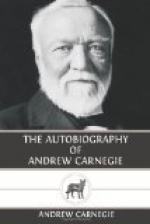But I had no idea of allowing the fish to play so long, and informed him that I would have a telegram in the morning agreeing to all the changes. The Atlantic cable had been open for some time, but it is doubtful if it had yet carried so long a private cable as I sent that day. It was an easy matter to number the lines of the bond and then going carefully over them to state what changes, omissions, or additions were required in each line. I showed Mr. Morgan the message before sending it and he said:
“Well, young man, if you succeed in that you deserve a red mark.”
When I entered the office next morning, I found on the desk that had been appropriated to my use in Mr. Morgan’s private office the colored envelope which contained the answer. There it was: “Board meeting last night; changes all approved.” “Now, Mr. Morgan,” I said, “we can proceed, assuming that the bond is as your lawyers desire.” The papers were soon closed.
[Illustration: JUNIUS SPENCER MORGAN]
While I was in the office Mr. Sampson, the financial editor of “The Times,” came in. I had an interview with him, well knowing that a few words from him would go far in lifting the price of the bonds on the Exchange. American securities had recently been fiercely attacked, owing to the proceedings of Fisk and Gould in connection with the Erie Railway Company, and their control of the judges in New York, who seemed to do their bidding. I knew this would be handed out as an objection, and therefore I met it at once. I called Mr. Sampson’s attention to the fact that the charter of the St. Louis Bridge Company was from the National Government. In case of necessity appeal lay directly to the Supreme Court of the United States, a body vying with their own high tribunals. He said he would be delighted to give prominence to this commendable feature. I described the bridge as a toll-gate on the continental highway and this appeared to please him. It was all plain and easy sailing, and when he left the office, Mr. Morgan clapped me on the shoulder and said:
“Thank you, young man; you have raised the price of those bonds five per cent this morning.”
“All right, Mr. Morgan,” I replied; “now show me how I can raise them five per cent more for you.”
The issue was a great success, and the money for the St. Louis Bridge was obtained. I had a considerable margin of profit upon the negotiation. This was my first financial negotiation with the bankers of Europe. Mr. Pullman told me a few days later that Mr. Morgan at a dinner party had told the telegraphic incident and predicted, “That young man will be heard from.”




